Allan T. Showler
Kika de la Garza Subtropical Agricultural Research Center
USDA-ARS
2413 E. Highway 83
Weslaco, Texas 78596 USA
[formerly with African Emergency Locust/Grasshopper Office African Bureau, USAID]
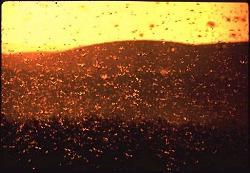
Plagues of desert locust, Schistocerca gregaria (Förskal), have been recognized as a threat to agricultural production in Africa and western Asia for thousands of years. Locust scourges are referred to in the Christian Bible and the Islamic Koran, and in some places, locust plagues have been held responsible for epidemics of human pathogens, such as cholera (this is because of the massive quantities of decomposing locust cadavers that would accumulate on beaches after swarms flew out to sea and drowned). Published accounts of locust invasions in North Africa date back to about AD 811, but more precise records were apparently not kept until the twentieth century (Showler 1993). Since then, it is known that desert locust plagues have occurred sporadically up until the present.
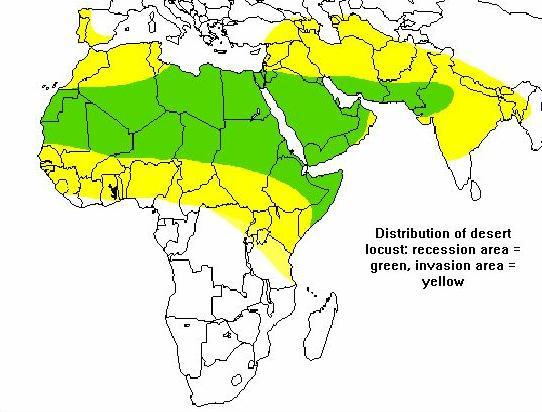
Normally, the desert locust is a solitary insect that occurs in desert and scrub regions of northern Africa, the Sahel (region including the countries of Burkina Faso, Chad, Mali, Mauritania, and Niger), the Arabian Peninsula (e.g., Saudi Arabia, Yemen, Oman), and parts of Asia to western India (Steedman 1988). During the solitary phase (green area on map), locust populations are low and present no economic threat. After periods of drought, when vegetation flushes occur in major desert locust breeding areas (e.g., India/Pakistan border), rapid population buildups and competition for food occasionally result in a transformation from solitary behavior to gregarious behavior on a regional scale (yellow area on map)(Showler 1995a,b). Following this transformation, which can occur over two or three generations (durations of locust life cycles are variable, depending on species and environmental conditions; in Africa, there are generally 3-5 generations per year) locusts often form dense bands of flightless nymphs and swarms of winged adults that can devastate agricultural areas.
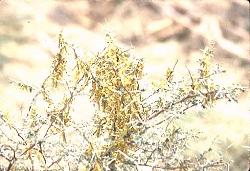
A locust outbreak or upsurge is the vaguely defined transition from the innocuous solitary phase to the plague stage which can be localized or cross-regional. During plagues, locust swarms and bands are found on an interregional scale and originate from a number of breeding areas as part of a widespread but interrelated locust breeding and migrating dynamic that can continue for years (Showler 1995b).
A single swarm of locusts can be small (hundreds of square meters) or huge, composed of billions of locusts, with up to 80 million per square kilometer over an area of more than 1,000 square kilometers. In one day, a swarm of locusts can fly 100 km in the general direction of prevailing winds. Bands of nymphs can march about 1.5 km per day (Steedman 1988). Plagues often involve hundreds of swarms, and the locusts' recession area can expand to envelop the Middle East, western Asia to Bangladesh, the sub-Sahel from Guinea to Tanzania, and parts of southern Europe.
Crop Loss
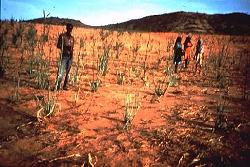
Desert locusts can consume the approximate equivalent of their body mass each day (2 g) in green vegetation: leaves, flowers, bark, stems, fruit, and seeds. Nearly all crops, and non crop plants, are at risk, including millet, rice, maize, sorghum, sugarcane, barley, cotton, fruit trees, date palm, vegetables, rangeland grasses, acacia, pines, and banana. Crop loss as a result of desert locust infestation is difficult to characterize, but it will be important for developing intervention strategies on a demonstrably cost-effective basis.
At this point, however, crop loss estimates are primarily anecdotal in nature, rather than being measured through systematic empirical means. Some of the more well established anecdotal examples include:
- In 1954-5, Morocco lost >$50 million (in 1994 dollars) to desert locusts in six weeks in the Sousse Massa Valley alone.
- In 1958, Ethiopia lost 167,000 tons of grain, enough to feed a million people for a year (Steedman 1988).
To estimate crop losses in the absence of chemical control, Potter and Showler (1990) constructed a hypothetical situation focused upon Tunisia during a locust plague:
If one assumes that the heaviest desert locust infestations come in the central and southern portions of the country around Kasserine and Gafsa, as they did in spring 1988 (Khoury et al. 1989), a total of about 552,000 ha devoted to grain production would be at risk to locust damage. This surface area is less than the maximum amount of land that the crop protection service was prepared to treat in 1988 (approximately 1,000,000 ha [Khoury et al. 1989]). Converting area cultivated to crop production, the net worth of grain that could be easily lost to desert locust consumption during such an invasion equals about twenty-nine million dollars (INS 1987). To put these potential losses into perspective, the amount of arable land devoted to grain cultivation in Tunisia was approximately 1,363,000 ha in 1986 (INS 1987). This harvest normally represents 72 million dollars of net annual cereal production. Under the scenario presented above, Tunisia could lose 40% of its yearly wheat and barley production if desert locust swarms were not controlled and they completely consumed grain crops in the principal infestation zones of the central and southern regions. Looking at potential crop losses due to desert locust impacts in another context, Tunisia received between 59,000 and 210,000 metric tons of food aid annually from 1972-1984 (FAO 1985). These figures represent from fourteen to forty-eight million dollars per year of grain donated by the international community. It is therefore reasonable to conclude that desert locust swarms are capable of consuming a cereal harvest equivalent in value to the current annual food aid received by Tunisia.
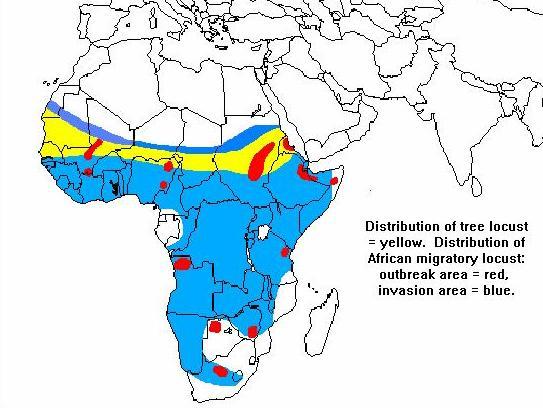
There have been attempts to characterize crop losses due to locusts on national or regional levels based upon hard cash harvest profits, then to arrive at the conclusion that losses are not important enough to warrant control operations. Analysis of cash economics, however, is incomplete without reflecting upon the inestimable value of the subsistence farmer and the subsistence agrarian society, ramifications of damage to pastureland and fodder (e.g., defoliation of fodder trees), and the expense of additional food aid from the international donor community. Care must also be taken to avoid separating the cost of locust damage from other factors that are often associated with, or even linked to, locust inflicted injury. Such factors (e.g., drought Striga, stalkborers, grasshoppers, concurrent outbreaks of other locusts [e.g., African migratory, tree, and Moroccan locusts], armyworm, and quelea birds) compound or are compounded by locust damage (Showler 1995c).
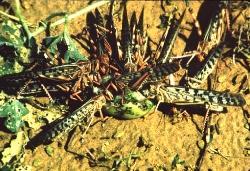
Also, it is misleading to apply estimates for a country in the Sahel, for example, to the Horn of Africa (e.g., Eritrea, Ethiopia, Somalia, Sudan), the Arabian Peninsula, the Maghreb (Morocco, Algeria, Tunisia, Libya), or India and Pakistan because of the general differences among economies, resources, infrastructure, and cropping zones in physical relation to critical locust breeding areas.
Locust inflicted damage, in addition to occurring very sporadically, is geographically patchy, owing to the nature of swarms. That is, where swarms do not land, losses do not occur. Where swarms do land and feed, losses can be 100% within hours at the local level (such losses can occur to impoverished subsistence farmers in the Sahel, or to high value export growers in the Maghreb).
The Food and Agriculture Organization (FAO) of the United Nations and the international donor community (e.g., USA, UK, Germany, the Netherlands) have been developing studies to better understand the economic implications of locust plagues and the impacts of control campaign scenarios which will reflect dimensions inherent to the problem. These studies will, in addition to supplying much needed information on the nature of locust plagues, help in the development and evolution of the Emergency Prevention System (EMPRES) program now being planned by FAO, the international donor community, and the locust affected countries (more on EMPRES near the end of this chapter).
Survey and Control
Monitoring locust populations during recession periods to anticipate the onset of gregarious behavior and to locate locust bands and swarms for control operations during outbreaks and plagues is a difficult task that has become increasingly technologically sophisticated. Model-generated forecasts of locust population events and general patterns of swarm movement during outbreaks and plagues are attempted by FAO and by France's Programme de Recherches Interdisciplinaire Francais sur les Acridien du Sahel (PRIFAS) using weather and vegetation index information gathered from satellite platforms, meso-scale and synoptic-scale weather patterns, soil mapping, and probabilities based upon historical knowledge about locust population dynamics throughout the recession and plague distributions. Though useful, these tools are not always accurate or timely.
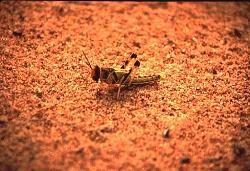
Despite the existence of such elaborate technology for roughly guiding locust scouts, the discovery of locust bands and swarms is accomplished through visual surveillance. Generally, survey and control operations are run by national crop protection services, though during plagues some national campaigns are run by the military. Aside from conducting surveys from 4X4 vehicles, light fixed wing aircraft, and helicopters, locust activity is also reported by military and police outposts, nomads, farmers, and even fire lookouts. Reports from neighboring countries on locust activity allowed many countries to anticipate and prepare for the arrival of swarms from across borders (Showler 1995a).
Controlling large bands and swarms of desert locusts has been attempted in different ways with varying degrees of success. Trenches can be dug near agricultural perimeters to catch nymphal bands marching toward crops where they can be buried. Smoke is, in some places, thought to repel swarms, but this does not seem to work. In some societies, a magic or holy man is summoned to dispel the bands and swarms with potions or incantations.
Natural enemies exist, including predatory and parasitic wasps and flies, predatory beetle larvae, birds, and reptiles, but they are easily overwhelmed by the sheer magnitude of most swarms and bands. Along these lines, some observers remark that such a huge biomass could be harvested as human food. Locusts are, in many African and Asian cultures, a dietary item sold on the open market. In much of French-speaking West and North Africa, desert locusts are jokingly referred to as ;crevettes du Sahara, or shrimp of the desert. Locusts are generally dried, fried, boiled, or grilled. In some areas, locusts are even thought to have medicinal properties; for example, in parts of Algeria locusts are regarded as being a palliative for diabetes. However, this cannot be construed as being a feasible or effective method of combatting cross-regional plagues. Also, because of the current reliance on insecticides for locust control, consumption of locusts is discouraged during campaigns.
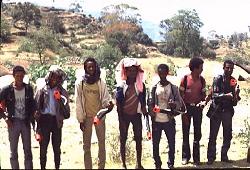
Photograph: Backpack sprayer brigade on the steep eastern escarpment of Eritrea (Allan Showler)
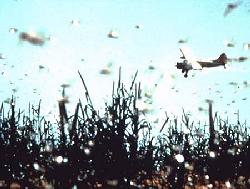
At this point, the only available and effective control tactic is insecticides. Prior to the late 1980's, chlorinated hydrocarbon insecticides, such as dieldrin and lindane, were sprayed on vegetation to create barriers against marching and feeding nymphal bands. This was a critical method of preventive control because of the persistence, the efficacy, and the mode of application (in bands or barriers) of these chemicals if used in desert locust breeding areas. However, as a result of concerns about the fate of such insecticides in the environment, the use of these chemicals has largely been discontinued. The 1986-1989 emergency crop protection campaign was pivotal in the sense that it was conducted when persistent chlorinated hydrocarbon insecticides were being phased out of the insecticide arsenal, and reliance on more selective, but less persistent, insecticides (e.g., malathion, chlorpyrifos, fenitrothion, deltamethrin, carbaryl, and lamda cyhalothrin mostly as ultra low volume formulations, though other formulations were also used, such as emulsifiable concentrates, dusts, and wettable powders) became the rule. Without persistent chemicals for barrier spraying, control with less persistent insecticides required making applications against each nymphal band. Despite the fact that long residual insecticides are no longer viewed as being acceptable, there has been considerable debate about whether fewer persistent insecticide applications is more potentially hazardous than greater area coverage with less persistent, more selective insecticides.
Control operations, whether conducted by aircraft, truck, or backpack sprayer, are usually conducted prior to 0900 hours before swarms begin to fly for the day, or when they have roosted in the evening. Spray campaigns are usually run by the national crop protection service, though some have been managed by the military (Showler 1993). In some areas, regional locust control organizations exist to augment survey and control carried out by the national governments. The Desert Locust Control Organization (DLCO), for example, specializes in aerial surveillance and control for East Africa. The Organization Commune de Lutte Antiacridienne et de Lutte Antiaviare (OCLALAV) performed terrestrial and aerial survey for West Africa (it is now nonoperational - see section on funding). The more recently formed Force Maghrebine is composed of Algerian, Tunisian, Moroccan, Libyan, and Mauritanian personnel who conduct terrestrial survey in the Maghreb and in neighboring Sahelian countries (Showler & Potter 1991, Showler 1995b).
Generally, a successful control operation would result in the elimination of at least 80% of a swarm or band. On the more macro scale, however, the relative numbers of swarms or bands that must be eliminated to stop the various stages of an outbreak or plague have not been determined. It is conceivable that such information, tailored to specific scenarios and regions, could lead to the development of intervention threshold levels to thwart outbreaks or plagues.
Recent Campaigns
1986-1989 Plague
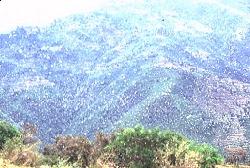
In 1986, a desert locust outbreak occurred in Sudan, Eritrea, and Ethiopia. Largely because of armed conflict in those countries, adequate control could not be conducted, and resulting massive swarms moved west across the Sahel. More breeding occurred in the Adrar des Iforas Mts of Mali, the Tibesti Mts of Chad, the Air Mts and the Tamesna of Niger, the Red Sea Hills of Sudan, and to a lesser extent, in Senegal, Mauritania, Morocco, Saudi Arabia, and southern Algeria until early 1989
Major desert locust invasions occurred in 23 countries (Table 1), and control operations covered about 25.9 million ha mostly with the aim of protecting cropping zones at immediate risk. An emergency crop protection approach, instead of intervening in the breeding areas, was taken for several reasons:
- Unpreparedness. Locust invasions overwhelmed existing control capabilities and caused fear of serious crop loss. Despite FAO warnings, government crop protection personnel could not shift immediately from routine pest management activities to combat the sudden locust invasions. Some regional control organizations were unable to respond to the widespread outbreaks because of inadequate funding by member nations over previous years.
- Competing Pressures. Outbreaks of the Senegalese grasshopper across the Sahel compounded the challenges posed by the desert locust plague. The Sahel is periodically threatened by drought and pests, and conservation of its subsistence agriculture was imperative. Similarly, North African national economies depend heavily on agricultural production; the locust plague placed their subsistence and valuable export crops at risk. Also, because North Africa did not harbor major breeding areas, efforts were aimed at crop protection there.
- Remote Breeding Areas. Extensive breeding occurred mostly in the vast and rugged Sahara, which precluded timely deployment of resources to critical breeding areas.
- Ill-defined Responsibilities. Some Sahelian countries showed little capacity for intervening in their remote northern breeding areas, arguing that breeding did not immediately threaten their own crops. Such breeding, however, did pose an immediate threat to neighboring countries. Adjacent countries, however, usually were not allowed to conduct cross-border survey and control operations. In particular, North African concerns for their high value cash crops arose from vulnerability to locust invasions emanating from breeding areas in the Sahel.
- Armed Conflict. The origin of this plague was in northern Ethiopia (now Eritrea) and Sudan, both areas where armed conflicts debilitated or precluded early intervention.
- The emergency crop protection effort was largely successful, but it cost about $310 million to the international donor community. In early 1989, many experts agreed that the plague would continue unabated for another seven years. The plague ended in the spring of 1989, but crop protection tactics did not stop the locust breeding cycle. Instead, four conditions were apparently responsible for breaking the plague.
- Storm Front. In October 1988 a storm front from West Africa carried swarms across the Atlantic Ocean to the Caribbean, from Trinidad to the Virgin Islands. The numbers of locusts that drowned en route must have been significant, based on the estimated quantity the survived or were washed ashore dead.
- North African Winter. A cold 1988-1989 winter in North Africa stopped the expected eastward movement of swarms along the Mediterranean coast before they could turn south with northerly spring winds to the breeding areas of the northern Sahel.
- Control in North Africa. Swarms were controlled in North Africa before they could breed and move on to the Sahel. North African countries had more resources for locust control than most other locust affected countries and did not experience simultaneous grasshopper outbreaks. In the fall of 1988 alone, about one million ha were sprayed in Morocco; by November up to 81,0000 ha were being treated per day. Algerian and Tunisian control operations eliminated those swarms that escaped.
- Dry Weather. Probably the most important cause for the decline of the plague was a drying trend at critical times and in critical places such that extensive breeding ceased. About 20 mm of rain must fall before soil is suitable for desert locust oviposition.
1992-1994 Outbreak
A general descriptive chronology of locust movements is presented (it is too cumbersome to provide such a chronology for the 1986-1989 plague) in the following paragraphs to illustrate some ways in which locust population dynamics work.
A pronounced desert locust outbreak began in late 1992 along the Red Sea coastal plains of Sudan and Eritrea following several years of drought. Swarms that escaped control moved across the Red Sea to the Tihama region of Yemen and Saudi Arabia where breeding conditions also were favorable. During the next three months, desert locust populations increased on both sides of the Red Sea coast and swarms then moved to southeastern Egypt. Swarms from the Red Sea coastal lowlands moved to and bred in Saudi Arabia's interior. In May and June, 1993, locust populations in Eritrea, Sudan, and Yemen developed into a serious outbreak, and swarms from Sudan's coast moved to the interior of that country where breeding continued. To complicate matters, there were concurrent outbreaks of African migratory locusts in Ethiopia and northern Somalia, and tree locusts in Sudan and Eritrea.
Drying conditions along the Red Sea coast caused desert locust swarms to move eastward from the Tihama to the Cholistan and Tharparkar deserts that straddle the Pakistan-India border (they flew across the Persian Gulf), and from Sudan westward across the northern Sahel (where, unexpectedly, breeding did not occur) to Mauritania. During September, 1993, breeding in Sudan's interior continued, and egg laying was occurring in south-central Mauritania (>80 swarms were found there in the first half of the month). In Pakistan and India, an already serious outbreak intensified, but began to decline during the latter half of the month.
In October, the desert locust outbreak in central Mauritania expanded to northwestern Senegal and northwestern Mauritania, and swarms were reported from southern Western Sahara. Gregarious locusts were not detected elsewhere in the Sahel, Arabian Peninsula, or Horn of Africa except for residual populations in Sudan's interior. Control operations in India and Pakistan had, at this time, contained a second generation of locusts.
Although the outbreak in southern and central Mauritania was declining by November, it persisted until the early summer of 1995 (the cross-regional outbreak, however, ceased in 1994), and populations were suspected to have bred in Western Sahara. Small swarms, presumably from Mauritania and Western Sahara, were found in southern Morocco until March 1994. Swarms that had moved from Mauritania to northern Senegal crossed into Gambia and Guinea Bissau in February and March. The cross-regional outbreak ended in April and May when only small swarms were found moving northward into southern Mali from Guinea.
Armed conflicts in the Red Sea region had been resolved by the end of 1992, so control operations were initiated quickly against gregarious populations, relative to the 1986-1989 campaign; most gregarious population surges and invasions were suppressed within one or two generations. In contrast to the 1986-1989 campaign, 4 million ha were sprayed during the 1992-1994 campaign at a cost of $18.75 million. While climatic factors played a role in modulating the dynamic of the 1992-1994 outbreak, it appears likely that control operations made important contributions toward containing the outbreak. The outcome of the 1992-1994 locust control campaign provided enough incentive for FAO, locust affected countries, and the international donor community to seriously consider supporting a plan for an early intervention program against desert locusts to be centered in the Red Sea region (see section on EMPRES).
1995 Outbreak
In 1995, conditions in Sudan's interior and/or northeastern Chad resulted in the production of mobile swarms by the end of the summer. Control operations were being conducted in Sudan, but they were not sufficient to prevent swarms from moving into Eritrea and Saudi Arabia. Limited breeding occurred in the Eritrean western lowlands, but the resulting nymphal bands were quickly controlled. By September, swarms moved across the Eritrean highlands and threatened to continue into the southern provinces (Eritrea's vital breadbasket). Ground (crop protection service, farmer brigades, and armed forces) and aerial control operations (DLCO), however, eliminated them before they could reach the critical Red Sea coastal breeding area. Swarms arriving in Saudi Arabia from Sudan were controlled before they could reach the interior. The outbreak ceased, largely as a result of timely control operations, by the end of October. Had locust aggregations been detected and controlled in Chad and Sudan, it is conceivable that the outbreak conditions in Eritrea and Saudi Arabia could have been averted. Though the figures have not yet been tabulated, the area treated with insecticides, and the cost to the international donor community is far smaller than the areas treated and costs of the 1986-1989 and 1992-1994 campaigns.
Campaign Challenges
Attempting to impose control over an insect that can transform into tremendous and highly mobile swarms would pose a difficult enough problem. The daunting challenge of controlling desert locusts, however, is exacerbated by an array of other monumental obstacles, summarized below.
Terrain
Many locust breeding areas are located in vast remote, often featureless, and rugged terrain of the Sahara, the Horn of Africa, and the Arabian Peninsula. To a large extent, infrastructure is limited and poor, and access to critical zones can only be accomplished using 4X4 vehicles and aircraft. Some areas are so rugged that terrestrial vehicles and fixed wing aircraft are incapable of reaching them properly, and more expensive and often mechanically problematic helicopters are required. Ground crews have been known to become lost in the desert, and some have perished. Aircraft pilots have, in some cases, refused to fly sorties more than 20 kilometers from the few established roads in the Sahara. During the 1986-1989 plague, pilots had to rely on sometimes sketchy map coordinates called in the day before, often by untrained personnel. Once the airplane made it to the correct vicinity, ground scouts had to guide it to its target using burning tires and signal mirrors. With the advent of global positioning systems (GPS), however, locating spray targets by ground and by air has become more exacting. Still, the mobility of swarms, especially in rugged areas (e.g., mountains, deep ravines, and steep escarpments) allows them to, in some cases, "disappear" for several days until they emerge somewhere that is more accessible. Because of the vastness of the regions involved, many operations must be launched from remote camps and airstrips with prepositioned supplies and fuel.
Armed Conflict
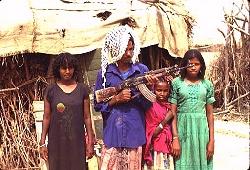
Photograph: Eritrean People's Liberation Front fighter, She'eb, Eritrea (Allan Showler)
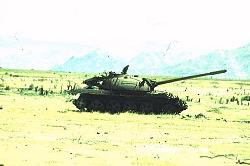
It is a facetious rule of thumb that desert locusts seem to be inexplicably attracted to areas where war is in progress. During the 1986-1989 plague, early intervention was impeded by armed conflict in the primary breeding areas of Eritrea and Sudan. Eritrea had been fighting a war of independence from Ethiopia for nearly 30 years, and though it is not commonly known in the U.S., some of the largest and most ferocious tank battles on the African continent were fought there. There was also a parallel independence struggle in the Tigray area of what is now northern Ethiopia. In Sudan, another violent civil war was being waged. Polisario separatist guerrillas fighting Morocco stopped survey and control in Western Sahara (in 1988, two U.S. C-130 spray aircraft enroute to Morocco from Senegal were hit with shoulder-fired rockets, killing the entire crew of one - the other barely made it to an airstrip in Morocco). Northern Eritrea and northern Mauritania, both key breeding areas, were, and are still, strewn with buried land mines (Showler 1995c) (in October, 1995, I had to hire a Rashaida nomad for two days as a guide to avoid minefields along parts of Eritrea's Red Sea coastal plains).
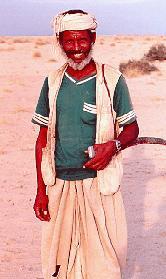
During the 1992-1994 outbreak, though the conflicts in Sudan, Eritrea, and Ethiopia had subsided, Tuareg nomads in northern Mali and northern Niger were in rebellion. On one occasion, five Malian soldiers providing armed escort for a locust survey team were ambushed and killed. The situation in Somalia was chaotic, with numerous heavily armed factions vying for power, massive displacements of refugees, a completely dissolved government, and bandit groups operating in Somalia and just across the border in parts of eastern Ethiopia's Ogaden region. In September, 1993, one survey helicopter crashed in the Ogaden, killing two passengers and seriously injuring others; though mechanical failure is a probable cause, light weapons fire has not been ruled out (the crash victims were ransacked). Polisario activity in Western Sahara continued to stymie locust survey and control in Western Sahara (Showler 1995c).
The short and very geographically limited campaign of 1995 was not significantly hindered by armed conflict. It is likely that this permitted sufficiently early control to eliminate the outbreak within two months.
Between the three most recent desert locust control campaigns, other conflicts occurred that have had varying degrees of negative impacts upon national capabilities for carrying out effective locust control campaigns. These conflicts include Chad's war against Libya in the mid-1980s, bloody racial unrest in Mauritania in 1989, the war against Iraq (Desert Storm) in 1990, intense Islamic fundamentalist assassinations and terror in Algeria in the early 1990s, and a civil war in Yemen in 1994.
Politics
In addition to those politics that result in the aforementioned armed conflicts, other political issues can be problematic. For example, because of the political situation in Sudan (the current government of Sudan apparently supports international terrorism), the U.S. has discontinued most or all of its assistance there. Other donor countries have also determined that their aid programs will not include support for Sudan. This has resulted in an obvious reduction in overall financial support for Sudan's locust control efforts. U.S. Assistance could similarly be denied to Mauritania in the near future, which is suspected of having committed human rights violations.
Other countries do not pass on timely information about locust activities. In most cases, cross border operations are not permitted. For example, it is very unlikely that Mali or Niger would allow the crop protection service of Algeria to operate within their border (though this has occurred nonetheless when Algeria conducted control operations just inside the Malian border during the 1986-1989 plague. One the other hand, regional locust survey and control organizations are allowed to operate wherever they are invited (within their mandate countries). The Force Maghrebine, composed of North African and Mauritanian teams, has carried out survey and control in Mali.
In some countries, coups or major shifts in ruling parties or governments can disrupt the structure and staffing of crop protection services. For example, the government of Ethiopia changed from being dominated by the Amhara (during the days of Haile Selasse), to the brutal Dergue regime (ruled by Haile Miriam Mengistu), and then, more recently, the government has been dominated by Tigrayans. There is a strong tendency to place loyalists, some of them not sufficiently experienced or qualified, in positions within the ministries, and the Ministry of Agriculture is no exception.
In a few countries, corruption at the government level is pervasive, and it greatly discourages nationals who attempt to conduct locust control, and the international donor community. Corrupt politics and practices have greatly reduced donor assistance to certain countries, and have hindered locust operations because of misappropriations and misallocations of funds and resources
Funds
Lack of funding in most locust affected countries is a major constraint to both protecting crops from locust invasions and conducting early interventions in breeding areas. Some countries, such as recently independent but war-torn Eritrea, have few resources with which to combat locusts. Others, including Eritrea, have few natural resources that have been adequately tapped, and are sporadically debilitated by drought. When I first visited the main desert locust breeding area along the Red Sea coast of Eritrea, the agricultural office in the settlement of She'eb (situated immediately adjacent to the breeding grounds), was made of sticks, twine, and some tattered plastic tarp (a concrete building replaced it in 1995). During the 1995 locust outbreak, Eritrea's crop protection service had only two vehicles with which to conduct survey, spray operations and carry out all routine activities as well (other vehicles were pooled from other ministries for the emergency).
Substantial assistance is contributed by the international donor community, including USAID (USA), DGIS (the Netherlands), CIRAD (France), CIDA (Canada), SIDA (Sweden), ODA (UK), and GTZ (Germany). Support is given for emergency equipment and material (e.g., radios, insecticides, fuel, aircraft flying hours, sprayers, safety clothing, and GPS units) and technical assistance, and for longer-term capacity building activities such as research projects and training. Without donor assistance, it is very probable that, for the time being, locust outbreaks will evolve quickly into full blown cross-regional plagues. On the other hand, the donors, through long-term activities, are striving with the lesser developed locust affected countries to achieve greater levels of self reliance.
Regional locust control organizations such as DLCO and OCLALAV are in various states of disrepair. OCLALAV, once a highly esteemed and very able survey organization, had not been receiving its annual dues from the member countries, and hence diminished from being fully functional with field staff and vehicles to a staff of two persons in Dakar, Senegal, who now can only collect and disseminate information. DLCO has also not been provided with funds from its member countries. Although DLCO maintains a very useful fleet of aircraft, it is far in arrears and its future looks dismal. The Force Maghrebine, however, is funded largely by North African countries and by donors, and it is assembled on a more "as needed" basis which seems to be working well.
Strategies
There are basically four approaches to locust control, not all of which are desirable or practical.
Inaction
I have heard some assertions from very limited quarters in Europe that, even during plague years, locusts cause too little overall damage at the national level to warrant control efforts (this idea is based on one or two studies limited to certain Sahelian countries, and on gross national economics that do not account for the various aspects of locust damage and associated damage caused by other factors as summarized in the Crop Loss section of this chapter). Evidence suggests that this is not universally true, but even if it were, locusts are capable of causing total crop loss within hours at the local level. Denial of requests for donor assistance (especially when made as disaster declarations by ambassadors) can be viewed as being morally and politically unacceptable for regions where crop production is vital to the survival of farmers, and sometimes governments.
Reaction
The 1986-1989 desert locust campaign exemplifies the reactive approach, but it is generally not adopted by choice. A reactive approach is taken on an emergency basis to protect crops after plague status has been reached, and it likely would not involve conducting control in critical breeding areas.
Proaction
The word "proactive" means early intervention to mitigate or avert further development of a problem. In the context of locusts, proaction entails intervention against localized outbreaks before plague status is reached (Showler 1995b). Proaction relies on early detection of bands and swarms, preferably in breeding areas, and strategic prepositioning of resources. Without empirical intervention threshold levels, timing of intervention is determined through a blend of estimated gregarizing locust populations, local capacity for control, experience, intuition, gestalt, and political pressure. Empirically rational intervention decisions should be determined through an improved understanding of the impacts of control measures applied against gregarizing locusts. The 1992-1994 campaign represents a proactive approach, even if locust populations spread to other regions, and the infestation of Mauritania lasted longer than expected (Showler 1995c).
Prevention
Ideally, locust control should occur at or prior to the onset of gregarious behavior when locusts, preferably in the less mobile and nonreproductive nymphal stage, have amassed in small patches no more than several square meters in diameter in breeding areas. Success would likely require that a critical, though as yet undetermined, proportion of these patches be controlled with the ultimate aim of holding locust populations in the recession phase indefinitely. Unfortunately, we have not yet developed this capability (Showler 1995b).
Aftermath
Carrying out a campaign against desert locusts is a complex and, at times, perilous venture, but the complexity does not end with the cessation of swarming.
The Environment
Controlling desert locust outbreaks and plagues with insecticides can, of course, pose environmental hazards. In particular, reactive campaigns are neither economically desirable nor environmentally advisable. Insecticide applications occur throughout a gradient of ecosystems: xeric desert, lush coastal hills, fertile Mediterranean flatlands, wetlands, islands, mountains, steppes, wadis (riverbeds), and oases. Habitat destruction for African flora and fauna from overgrazing, deforestation, and other unsustainable practices has caused ecological disruption that could be compounded by massive emergency insecticide applications. Some environments are particularly vulnerable to the introduction of toxins, especially coastal wetlands, wadis, and oases which provide critical habitats for migratory avian species in addition to more stationary indigenous species. Wildlife is at risk because it cannot be excluded from sprayed areas.
Although few notable environmental perturbations were observed following spray operations during the last three campaigns, incidents of animal poisoning may have nevertheless occurred. It is difficult to ascertain the number of wild animals that may have succumbed to pesticides, but several instances involved kills of small birds around contaminated puddles of water, and of reptiles and nontarget arthropods. Also, while beekeepers were warned to move or cover their hives prior to spray operations, some ignored the cautions and their colonies were either severely weakened or killed (Showler 1995a).
Few studies have examined the impacts of anti-locust insecticides on the African environment. However, it has been ascertained through studies in Mali, Sudan, Morocco, and Senegal that have determined that terrestrial and aquatic life could, depending on the insecticide, be adversely affected.
Human Health
Effects of anti-locust insecticides on humans have been noted primarily among pesticide handlers and applicators. The most commonly used insecticides during the three campaigns were malathion, fenitrothion, chlorpyrifos, deltamethrin, and lambda cyhalothrin - all moderately or slightly toxic to humans; adverse effects on humans as a result of these insecticides were not reported. Direct exposure to these insecticides occurred primarily as a result of improper equipment maintenance, pesticide handling, and application (safety clothing and other precautions were not always used during spray operations).
Control operations have most often been conducted in uninhabited areas or rangeland where public exposure was minimal. Rural populations, including nomads, were warned about imminent spray operations and public announcements were issued against consumption of locusts.
Unfortunately, there have been no programs to monitor pesticide exposure, though in some countries, acetylcholinesterase (AChE) titers in the blood of insecticide handlers and applicators were measured. In Morocco, where a relatively acutely toxic and highly volatile insecticide was being used (DDVP - not approved for use against locusts by USAID or the USEPA) in addition to malathion and other more universally accepted insecticides, about 1,000 persons were removed from spray operations temporarily or permanently during the 1986-1989 campaign because of low AChE titers. About 500 blood samples were taken at random from the general population, but low AChE titers were not detected.
For a more detailed treatment of environmental issues, refer to Showler (1995a).
Unwanted Pesticides and Empty Pesticide Containers
Large stocks of unusable, obsolete, environmentally undesirable or banned insecticides have accumulated in many locust affected countries, particularly as a result of the 1986-1989 campaign and other campaigns before it. These stocks are a problem mostly for two reasons: 1) they are often stored in deteriorating containers such that pesticide spills and leaks are likely to occur in the future, and 2) they may actually be used for pest control when stocks of preferred pesticides are exhausted. Some of the unwanted stocks, especially chlorinated hydrocarbon insecticides, have been stored for about 30 years, and in many cases, the origin is not documented and labels are missing or no longer legible. Unwanted pesticide stocks can be quite large and thus present logistical storage problems.
At this time, unwanted stocks cannot be properly disposed of in Africa or Asia. Incineration can be effective and environmentally feasible, but most African and Asian countries have rejected this option. Instead, unwanted stocks in one or two countries have been transported to Europe for incineration there. This solution, however, is not developmentally oriented, it is expensive, and the shipment of such stocks overland and by sea present additional hazards. Spraying the stocks out over uninhabited desert areas, using them to combat pests, or burying them are all possible options but none of these are regarded as being acceptable.
In addition to potential environmental and human health risks associated with large stocks of unwanted pesticides, there is the dilemma of dealing with empty pesticide containers - usually 200 liter metal barrels. The primary concern about empty pesticide barrels is the high demand for their use by the general public as storage containers, including for food and water. In some cases, empty barrels have been sold on the market despite the fact that this practice is unsafe. It is for this reason that used pesticide barrels need to be rendered useless, reconditioned, or decontaminated. Because there are presently no economical options for reconditioning or decontaminating empty drums, the only available avenue remains storing the empty containers until a better solution is identified, or rendering them useless by flattening and puncturing, and then burying them in secure areas where the water table is very low.
A more complete discussion of disposal of unwanted pesticides can be found in Showler (1995a).
Current Research Directions
Research has aimed mostly to improve early warning and detection of locust populations and movements, and to develop less toxic methods to minimize reliance on insecticides. Research that will help enable early detection (which is essential for proactive and preventive control) includes (but is not limited to):
- exploration and refinement of GIS technologies to better identify locust breeding areas,
- improvement of remote sensing methods,
- ground verification of vegetation index maps,
- studies to better understand locust behaviors (especially phase transformation from solitary to gregarious),
- studies on locust population dynamics such that models might be developed, and
- design of physical detection modalities (e.g., radar aircraft) to locate swarms more effectively from farther away.
Research that is being carried out on alternatives to conventional insecticides includes (but is not limited to) the following.
- Exploration for, identification, assay and formulation of microbial biological control agents; so far, the best results have been obtained from studies in Mali, Cape Verde, and Madagascar where various fungal entomopathogens have been isolated and shown promise for locust control. Because microbial pathogens tend to kill locusts slowly (3-7 days to achieve 80-90% kill for the more promising strains of Beauveria and Metarhizium) this tactic will most likely be used for managing locust populations in their breeding areas in preventive or proactive contexts. On the other hand, if small amounts of a rapid knockdown insecticide (e.g., many pyrethroids) were mixed with the biocontrol agent, such a formulation could be useful for controlling swarms that have moved beyond the breeding areas.
- Research on the possible use of botanical extracts, especially as repellents, is being conducted.
- Studies on insect growth regulators for locust control, especially diflubenzuron (dimilin), are being carried out.
- Research on new insecticide application equipment and methods, and on the development of new or improved conventional insecticides.
- Studies on semiochemicals for disrupting or manipulating locust behaviors.
It is hoped that research will yield practical tools for incorporating into locust control strategies, particularly for making a preventive approach possible, and for increasing the effectiveness of proactive operations.
Training
Although facilitation of greater self-reliance for locust control on the part national crop protection services depends to some degree on material resources, infrastructure, unobstructive politics, and cessation of armed conflict in key locust breeding areas, training is one of the most essential ingredients to success. Many donors and FAO conduct training courses relevant to locust control, but some of these training events are carried out as nonparticipatory lectures that are taught solely by Europeans, Australians, and Americans. Once the training session is completed, the foreign instructors depart without follow-on activities that would provide sufficient momentum for the course to have tangible, longer lasting effects.
USAID's Africa Emergency Locust/Grasshopper Assistance (AELGA) Project has been conducting training in Africa which differs from the normal modality. AELGA's training is conducted at the country specific level (as opposed to regional training courses, for example, on how to carry out research on developing biological control agents) and it is completed in three stages. During the first phase, for crop protection service officers, a few Western specialists are called in to give specific lectures that cannot be done by local experts. Otherwise, the course is taught by fellow nationals. Aside from the technical material to be covered, a significant portion of the course is devoted to preparing annual action plans for pest management, and how to teach extension agents and farmers. The second phase, conducted several months after the completion of the first phase, focuses on teaching a cadre extension agents, using crop protection service officers trained during phase 1 as instructors and, where needed, other in-country expertise. The third phase also relies 100% on instruction by trainees from phases 1 and 2, and it is aimed at farmer leaders. In phases 2 and 3, advance planning and teaching methods remain an important part of the curriculum. Each course lasts 7 - 10 days, and in the cases of phases 2 and 3, the course is repeated in several provincial capitals to handle a larger number of students throughout the country. So far, this method of training has had excellent results and it is being internationally recognized for its innovation and positive impacts.
AELGA's regional training courses generally involve an appropriate mixture of foreign (non-African instructors) and African experts to teach trainees from a variety of countries in a particular region. For example, in the fall of 1995, AELGA held a regional training with the International Center for Insect Physiology and Ecology (ICIPE) in Nairobi, Kenya, for two scientists from each of the following countries: Egypt, Tanzania, Eritrea, Ethiopia, Kenya, Somalia, Uganda, Yemen, and Sudan. The course, on how to explore for, isolate, characterize, rear, formulate, and develop regulations for biological control agents, involved trainers from Canada, the USA, Kenya, and ICIPE.
Empires
FAO, the donor community and the locust affected countries have collaboratively devised a program for early intervention in the Red Sea coast region of East Africa and the Arabian Peninsula. The Emergency Prevention System (EMPRES) program will be carried out on a relatively limited budget, and it will not take the lead in conducting actual survey and control operations. Instead, the primary goal of EMPRES is: "To minimize the risk of desert locust plagues emanating from the central region of the desert locust distribution area through well-directed surveys and timely, environmentally sound interventions in order to mitigate food security concerns in the central region and beyond" (FAO 1995). The objective of the program is: "To promote and catalyze the realization of regional self sufficiency for averting locust plagues through strengthening existing national, regional, and international components of desert locust management systems (FAO 1995). EMPRES is in the latter stages of planning, and it is very likely that implementation will commence in 1996. This is the first internationally sponsored early intervention plan.
Conclusion
Pesticides by definition are toxic and negative environmental effects resulting from massive cross regional pesticide spray campaigns against locust outbreaks and plagues are unavoidable. Ideally, conventional pesticide use should be discontinued; but during the plague of 1986-1989, and for now, pesticides are the only available tactic for combating locusts. As research efforts yield new tactics that minimize pesticide use in anti-locust campaigns, impacts on the environment and humans can be mitigated. Evolution toward the capacity to fight locust plagues with minimal risk to humans and the environment will depend a good deal upon policymakers from locust affected countries, the international donor community, and multilateral development organizations (i.e., FAO). They must promote environmental protection and an increasingly integrated approach to desert locust control to reduce or even eliminate pesticide use in regions where the environment is already in grave peril.
Accurate delivery of the least toxic insecticides to target areas, not located in fragile or protected habitats, should continue to be an objective of future campaigns when insecticides must be used. Discovery, development, and adoption of nonconventional chemical and biological means of locust control could replace conventional pesticide use in many situations and further decrease environmental risks.
Coordinated preventive and proactive control, whether by selective conventional insecticides or non-chemical tactics, would effectively eliminate large-scale crop protection spray campaigns against desert locusts. Implementation of preventive or proactive control programs in politically unstable countries or contested areas in remote terrain will require focused international collaboration. It will entail continuous survey, timely and rational intervention, detailed knowledge of the pest, and long-term financial commitment.
Preventive and proactive approaches to locust outbreak control using least disruptive tactics should be the ultimate goal. This would facilitate the pursuit of dependable agricultural production in many regions where food security is of vital importance to human survival.
References Cited
- FAO (Food and Agriculture Organization of the United Nations). 1985. Food aid in figures. FAO, Rome.
- FAO. 1995. Emergency Prevention System (EMPRES) for transboundary animal and plant pests and diseases: desert locust management in the central region. FAO, Rome, Italy.
- INS (Institut National de Statistiques). 1987. Annual report Tunis: Institut National de Statistiques.
- Khoury, H., C.S. Potter, H. Moore, and A. Messer. 1988. Technical mission report for the Tunisia locust control campaign. USAID, Washington, DC.
- Potter, C.S. & A.T. Showler. 1990. The desert locust: agricultural and economic impacts, pp. 153-166. In I.W.
- Zartman [ed.], Tunisia: the political economy of reform. Lynne Rienner, Boulder, CO.
- Showler, A.T. 1993. Desert locust, Schistocerca gregaria (Förskal) (Orthoptera: Acrididae), campaign in Tunisia, 1988. Agric. Systems 42:311-325.
- Showler, A.T. 1995a. Desert locust control, public health, and environmental sustainability in North Africa, pp. 217-239. In W.D. Swearingen & A. Bencherifa [eds.], The North African environment at risk. Westview Press, Boulder, CO.
- Showler, A.T. 1995b. Locust (Orthoptera: Acrididae) outbreak in Africa and Asia, 1992-1994: an overview. Amer. Entomol. 41: 179-185.
- Showler, A.T. 1997. Proaction: strategic framework for today's reality, pp. 461-465, In S. Krall, R. Peveling and D. Ba Diallo [eds.] New Strategies in Locust Control. Birkhauser, Basel, Switzerland.
- Showler, A.T. & C.S. Potter. 1991. Synopsis of the 1986-1989 desert locust (Orthoptera: Acrididae) plague and the concept of strategic control. Amer. Entomol. 37:106-110.
- Steedman, A. 1988. Locust Handbook. Overseas Development Agency.
- National Resources Institute, London, UK.
Table 1. Countries where desert locust infestations occurred.
| 1986-1989 | 1992-1994 | 1995 |
|---|---|---|
| Algeria | Algeria | Eritrea, b |
| Burkina Faso | Cape Verde | Saudi Arabia |
| Cameroon | Chad, d | Sudan |
| Cape Verde | Djibouti, d | |
| Chad | Egypt | |
| Eritrea, a,b,c | Eritrea, b | |
| Ethiopia, a | Ethiopia | |
| Gambia | Gambia | |
| India | Guinea Bissau | |
| Iran | India | |
| Iraq | Mali, a,d | |
| Jordan | Mauritania, b | |
| Kuwait | Morocco | |
| Mali | Niger, a,d | |
| Mauritania, b | Oman | |
| Morocco | Pakistan | |
| Niger | Saudi Arabia | |
| Pakistan | Senegal | |
| Saudi Arabia | Somalia, a,d | |
| Senegal | Sudan | |
| Sudan, a | Yemen | |
| Tunisia | Western Sahara, a | |
| Yemen |
a - Countries where locust survey and/or control were limited by armed conflict.
b - Some areas inaccessible because of land mines.
c - Eritrea was not independent from Ethiopia in the 1980s.
d - Locust invasions occurred but were not sprayed.